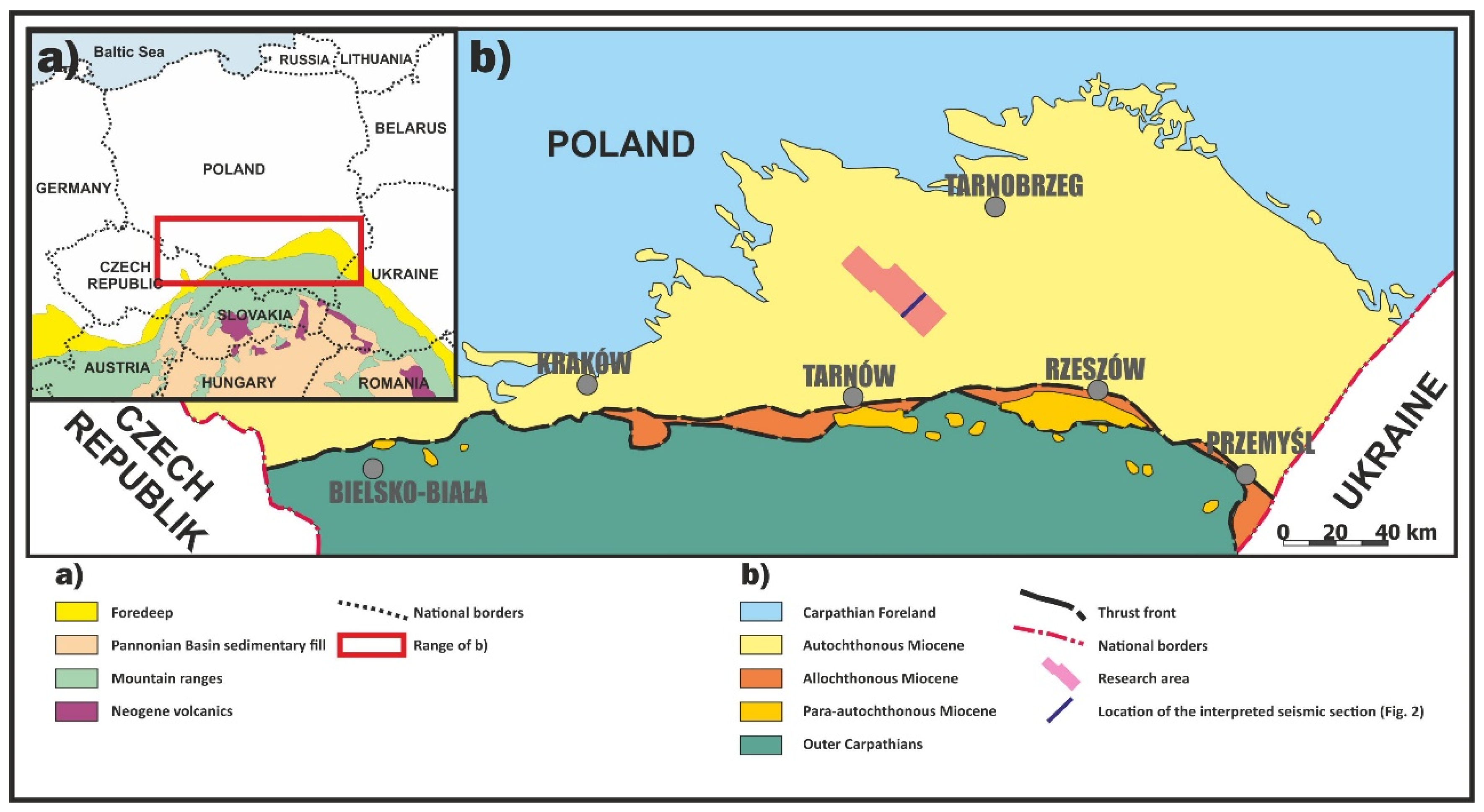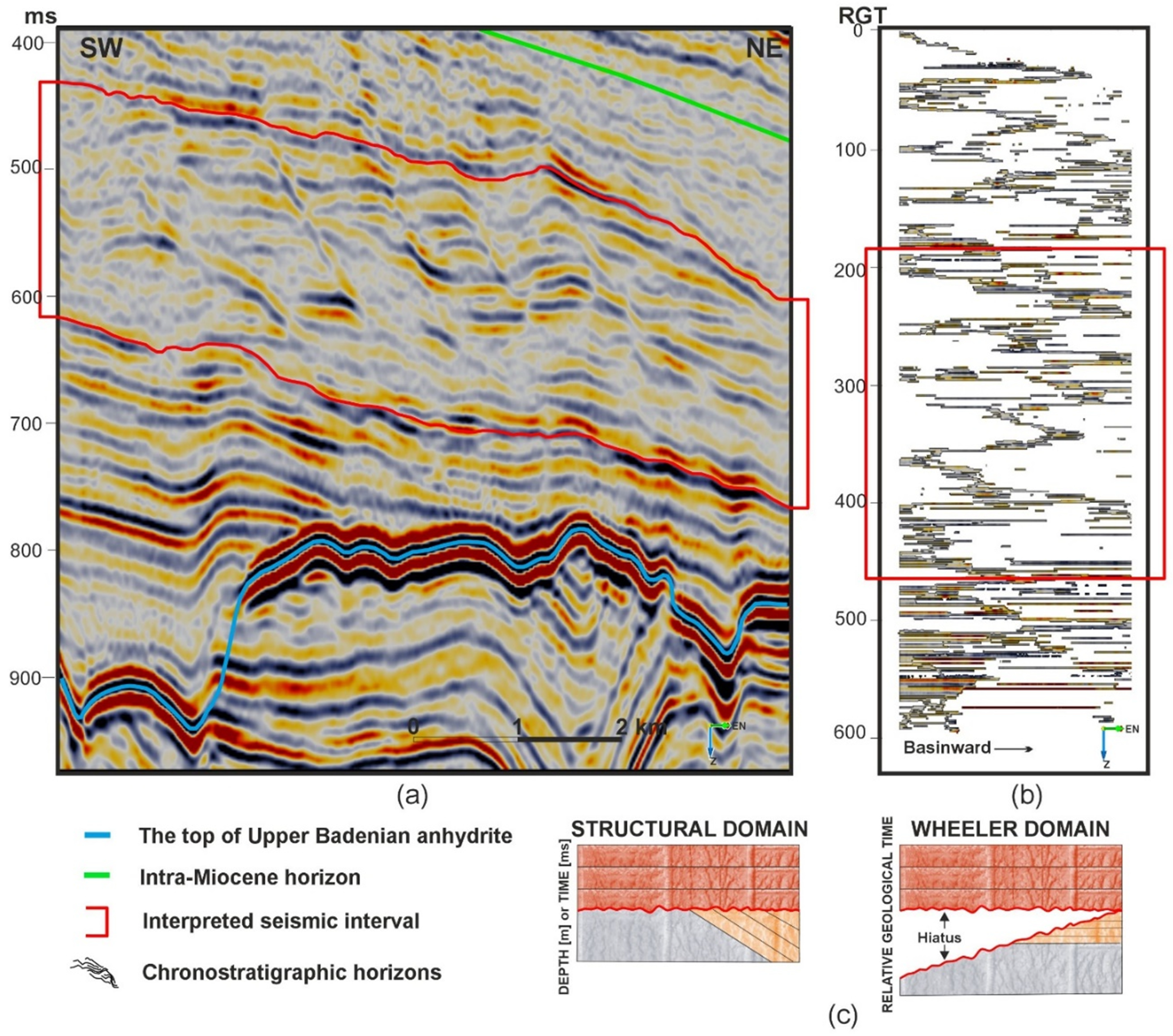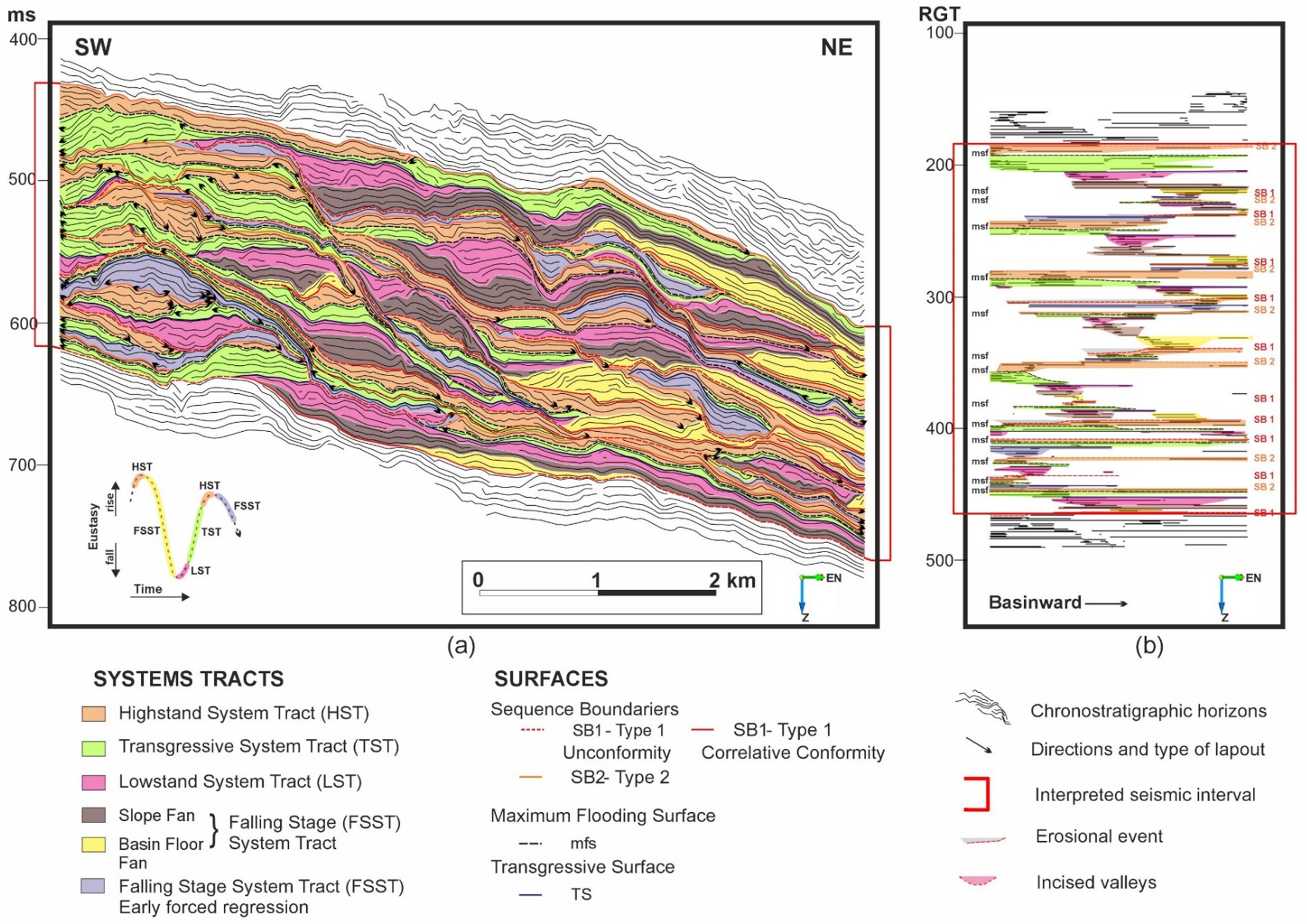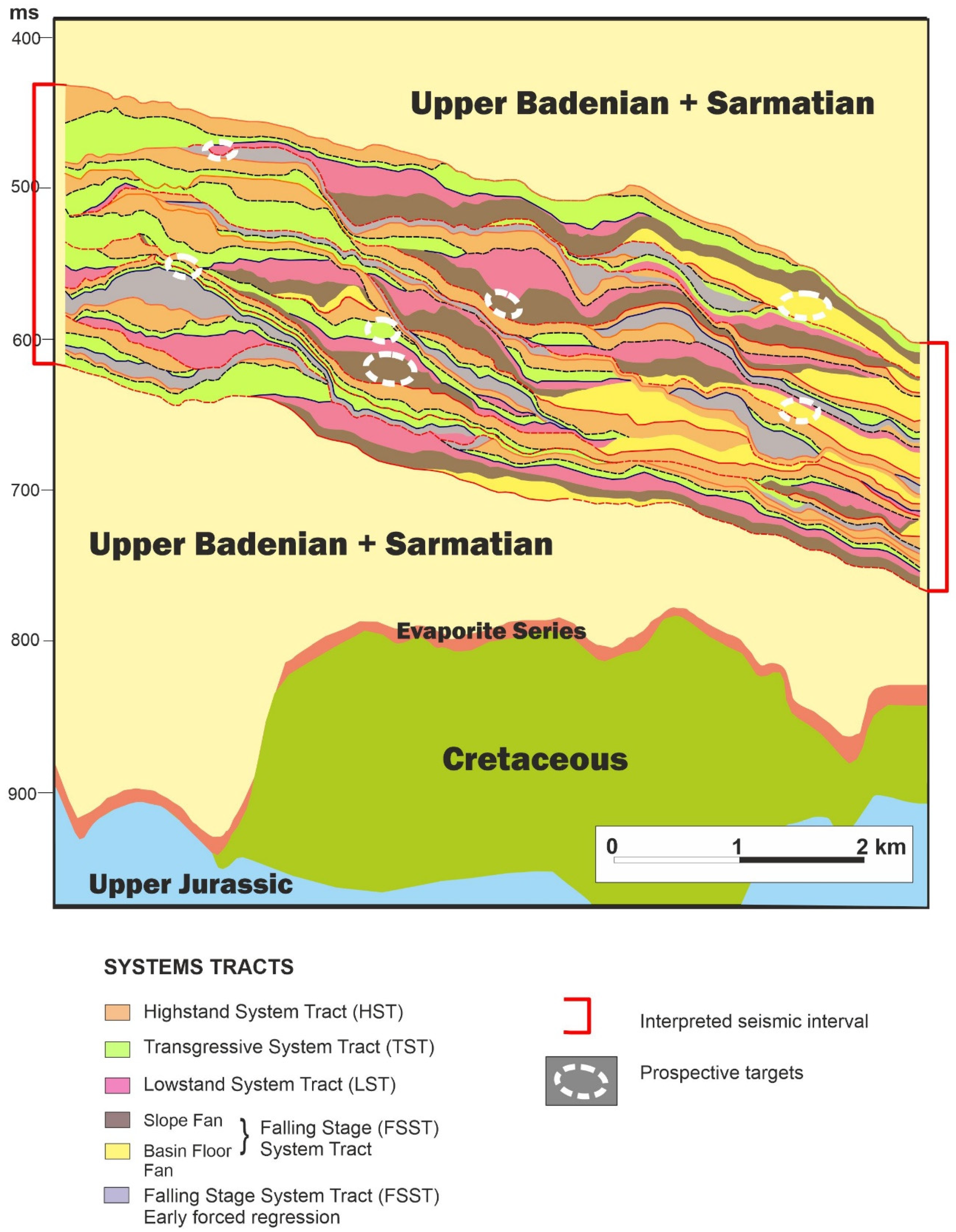Seismic Identification of Unconventional Heterogenous Reservoirs Based on Depositional History—A Case Study of the Polish Carpathian Foredeep
Abstract
1. Introduction
2. Geological Setting and Data Description
2.1. Geological Setting, the Survey Area
2.2. Definition of Heterogeneous Sequence
- dominated by mudstone;
- with an approximately equal proportion of sandstone/siltstone and mudstone;
- dominated by sandstone and siltstone.
2.3. Data Description
3. Methods
3.1. Depositional Analysis
3.2. Seismic Analysis
4. Results
4.1. Depositional Environments Characterization
4.2. Seismic Signatures for Unconventional Targets Prospecting
5. Discussion
6. Conclusions
Author Contributions
Funding
Acknowledgments
Conflicts of Interest
References
- Kotarba, M.J.; Wilczek, T.; Kosakowski, P.; Kowalski, A.; Wiȩcław, D. A study of organic matter and habitat of gaseous hydrocarbons in the Miocene strata of the Polish part of the Carpathian Foredeep. Prz. Geol. 1998, 46, 742–750. [Google Scholar]
- Kotarba, M.J. Origin of natural gases in the autochthonous miocene strata of the Polish Carpathian Foredeep. Ann. Soc. Geol. Pol. 2011, 81, 409–424. [Google Scholar]
- Matyasik, I.; Myśliwiec, M.; Leśniak, G.; Such, P. Relationship between Hydrocarbon Generation and Reservoir Development in the Carpathian Foreland (Poland). In Proceedings of the Thrust Belts and Foreland Basins; Springer: Berlin/Heidelberg, Germany, 2007; pp. 413–427. [Google Scholar]
- Kotarba, M.J.; Peryt, T.M.; Koltun, Y.V. Microbial Gassystem and Prospectives of Hydrocarbon Exploration in Miocene Strata of the Polish and Ukrainian Carpathian Foredeep. Ann. Soc. Geol. Pol. 2011, 81, 523–548. [Google Scholar]
- Thomas, R.G.; Smith, D.G.; Wood, J.M.; Visser, J.; Calverley-Range, E.A.; Koster, E.H. Inclined heterolithic stratification—Terminology, description, interpretation and significance. Sediment. Geol. 1987, 53, 123–179. [Google Scholar] [CrossRef]
- Lettley, C.D.; Pemberton, S.G. Speciation of McMurray Formation Inclined Heterolithic Strata: Varying Depositional Character Along a Riverine Estuary System. In Proceedings of the CSPG/CSEG GeoConvention, Calgary, AB, Canada, 31 May–4 June 2004; CSPG/CSEG Datapages: Calgary, AB, Canada, 2015; Volume 51067. [Google Scholar]
- Myśliwiec, M. Mioceńskie skały zbiornikowe zapadliska przedkarpackiego. Prz. Geol. 2004, 52, 581–592. [Google Scholar]
- Myśliwiec, M.; Plezia, B.; Świȩtnicka, G. Nowe odkrycia złȯz gazu ziemnego w osadach miocenu północno-wschodniej czȩści zapadliska przedkarpackiego na podstawie interpretacji bezpośredniego wpływu nasycenia wȩglowodorami na zapis sejsmiczny. Prz. Geol. 2004, 52, 395–402. [Google Scholar]
- Liszka, B.; Madej, K.; Paszkowski, M.; Porębski, S.J.; Ratusznik, Z.; Słyś, M.; Soliński, B.; Warchoł, M. Rozpoznanie heterolitowych obiektów złożowych w miocenie zapadliska przedkarpackiego pod kątem eksploatacji gazu otworami poziomymi. Pr. Inst. Naft. Gazu 2009, 158, 37–68. [Google Scholar]
- Nagymarosy, P.; Muller, P. Some Aspects of Neogene Biostratigraphic in the Pannonian Basin. In The Pannonian Basin: A Study in Basin Evolution Basin Evolution; American Association of Petroleum Geologists: Tulsa, OK, USA, 1988; pp. 69–77. [Google Scholar]
- Malvić, T. Review of Miocene shallow marine and lacustrine depositional environments in Northern Croatia. Geol. Q. 2012, 56, 493–504. [Google Scholar] [CrossRef]
- Pavelić, D.; Kovačić, M. Sedimentology and stratigraphy of the Neogene rift-type North Croatian Basin (Pannonian Basin System, Croatia): A review. Mar. Pet. Geol. 2018, 91, 455–469. [Google Scholar] [CrossRef]
- Sacchi, M.; Horváth, F. Towards a new time scale for the Upper Miocene continental series of the Pannonian basin (Central Paratethys). EGU Stephan Mueller Spec. Publ. Ser. 2002, 79–94. [Google Scholar] [CrossRef]
- Pietsch, K.; Porębski, S.J. The use of seismostratigraphy for exploration of Miocene gas-bearing reservoir facies in the NE part of the Carpathian Foreland Basin. Geologia 2010, 36, 173–186. [Google Scholar]
- Kwietniak, A.; Cichostępski, K.; Kasperska, M. Spectral Decomposition Using the CEEMD Method: A Case Study from the Carpathian Foredeep. Acta Geophys. 2016, 64, 1525–1541. [Google Scholar] [CrossRef]
- Łaba-Biel, A.; Smółka-Gnutek, P. Horizon cube i diagram Wheelera—Przykłady zastosowania w interpretacji obrazu sejsicznego. Pr. Nauk. INiG-PIB 2016, 209, 533–537. [Google Scholar]
- Łaba-Biel, A.; Smółka-Gnutek, P. Detaliczna, geologiczna analiza obrazu sejsmicznego w oparciu o interpretację diagramu Wheelera i Horizon Cube. Pr. Nauk. INiG-PIB 2016, 209, 223–229. [Google Scholar]
- Cichostępski, K.; Kwietniak, A.; Dec, J. Verification of bright spots in the presence of thin beds by AVO and spectral analysis in Miocene sediments of Carpathian Foredeep. Acta Geophys. 2019, 67, 1731–1745. [Google Scholar] [CrossRef]
- Oyem, A.; Castagna, J. Sorting and visualization of Spectral-decomposition data. Lead. Edge 2015, 34, 42–47. [Google Scholar] [CrossRef]
- Hart, B.S. Channel detection in 3-D seismic data sing sweetness. Am. Assoc. Pet. Geol. Bull. 2008, 92, 733–742. [Google Scholar] [CrossRef]
- Picha, F.J. Exploring for hydrocarbons under thrust belts—A challenging new frontier in the Carpathians and elsewhere. Am. Assoc. Pet. Geol. Bull. 1996, 80, 1547–1564. [Google Scholar]
- Porębski, S.J.; Warchoł, M. Hyperpycnal flows and deltaic clinoforms—Implications for sedimentological interpretations of late Middle Miocene fill in the Carpathian Foredeep Basin. Przegląd Geol. 2006, 54, 421–429. [Google Scholar]
- Moryc, W.; Jachowicz, M. Utwory prekambryjskie w rejonie Bochnia-Tarnów-Debica. Prz. Geol. 2000, 48, 601–606. [Google Scholar]
- Jachowicz-Zdanowska, M. Organic microfossil as sem blages from the late Ediacaran rocks of the Małopolska Block, southeast ern Poland. Geol. Q. 2011, 55, 85–94. [Google Scholar]
- Moryc, W.; Nehring-Lefeld, M. Ordovician between Pilzno and Busko in the Carpathian Foreland (Southern Poland). Geol. Q. 1997, 41, 139–150. [Google Scholar]
- Buła, Z.; Habryn, R. Precambrian and Palaeozoic basement of the Carpathian Foredeep and the adjacent outer Carpathians (SE Poland and Western Ukraine). Ann. Soc. Geol. Pol. 2011, 81, 221–239. [Google Scholar]
- Zając, R. Stratygrafia i rozwój facjalny dewonu i dolnego karbonu południowej części podłoza zapadliska przedkarpackiego. Kwart. Geol. 1984, 28, 291–316. [Google Scholar]
- Moryc, W. Budowa geologiczna podłoża miocenu w rejonie Kraków—Pilzno. Część 1. Prekambr i paleozoik (bez permu). Nafta-Gaz 2006, 62, 197–216. [Google Scholar]
- Urbaniec, A.; Bobrek, L.; Świetlik, B. Litostratygrafia i charakterystyka mikropaleontologiczna urworów krédy dolnej w środkowej czȩsci przedgórza Karpat. Prz. Geol. 2010, 58, 1161–1175. [Google Scholar]
- Gutowski, J.; Urbaniec, A.; Złonkiewicz, Z.; Bobrek, L.; Świetlik, B.; Gliniak, P. Upper Jurassic and Lower Cretaceous of the middle polish Carpathian foreland. Biul. Państwowego Inst. Geol. 2007, 426, 1–26. [Google Scholar]
- Urbaniec, A.; Bartoń, R.; Bajewski, Ł.; Wilk, A. Wyniki interpretacji strukturalnej utworów triasu i paleozoiku przedgórza Karpat opartej na nowych danych sejsmicznych. Nafta-Gaz 2020, 76, 559–568. [Google Scholar] [CrossRef]
- Jasionowski, M. Zarys litostratygrafii osadów mioceńskich wschodniej częsći zapadliska przedkarpackiego. Biul. Państwowego Inst. Geol. 1997, 375, 43–59. [Google Scholar]
- Urbaniec, A.; Stadtmüller, M.; Bartoń, R. Possibility of a more detailed seismic interpretation within the Miocene formations of the Carpathian Foredeep based on the well logs interpretation. Nafta-Gaz 2019, 75, 527–544. [Google Scholar] [CrossRef]
- Alexandrowicz, S.W.; Garlicki, A.; Rutkowski, J. Podstawowe jednostki litostratygraficzne miocenu zapadliska przedkarpackiego. Kwart. Geol. 1982, 26, 470–471. [Google Scholar]
- Báldi, K. Paleoceanography and climate of the Badenian (Middle Miocene, 16.4-13.0 Ma) in the Central Paratethys based on foraminifera and stable isotope (δ18O and δ13C) evidence. Int. J. Earth Sci. 2006, 95, 119–142. [Google Scholar] [CrossRef]
- De Leeuw, A.; Bukowski, K.; Krijgsman, W.; Kuiper, K.F. Age of the Badenian salinity crisis; Impact of Miocene climate variability on the circum-mediterranean region. Geology 2010, 38, 715–718. [Google Scholar] [CrossRef]
- Karami, M.P.; de Leeuw, A.; Krijgsman, W.; Meijer, P.T.; Wortel, M.J.R. The role of gateways in the evolution of temperature and salinity of semi-enclosed basins: An oceanic box model for the Miocene Mediterranean Sea and Paratethys. Glob. Planet. Change 2011, 79, 73–88. [Google Scholar] [CrossRef]
- Bukowski, K. Rozprawy i Monografie; Wydawnictwa AGH: Kraków, Poland, 2011; pp. 1–184. [Google Scholar]
- Gaździcka, E. Nannoplankton stratigraphy of the Miocene deposits in Tarnobrzeg area (northeastern part of the Carpathian Foredeep). Kwart. Geol. 1994, 38, 553–569. [Google Scholar]
- Lis, P.; Wysocka, A. Middle Miocene deposits in Carpathian foredeep: Facies analysis and implications for hydrocarbon reservoir prospecting. Ann. Soc. Geol. Pol. 2012, 82, 239–253. [Google Scholar]
- Reineck, H.; Wunderlich, F. Classification and Origin of Flaser and Lenticular Bedding. Sedimentology 1968, 11, 99–104. [Google Scholar] [CrossRef]
- Terwindt, J.H.J.; Breusers, H.N.C. Experiments on the Origin of Flaser, Lenticular and Sand-Clay Alternating Bedding. Sedimentology 1972, 19, 85–98. [Google Scholar] [CrossRef]
- Martin, A.J. Flaser and wavy bedding in ephemeral streams: A modern and an ancient example. Sediment. Geol. 2000, 136, 1–5. [Google Scholar] [CrossRef]
- Jackson, M.D.; Yoshida, S.; Muggeridge, A.H.; Johnson, H.D. Three-dimensional reservoir characterization and flow simulation of heterolithic tidal sandstones. Am. Assoc. Pet. Geol. Bull. 2005, 89, 507–528. [Google Scholar] [CrossRef]
- Donselaar, C.R.; Geel, M.E. Facies architecture of heterolithic tidal deposits: The Holocene Holland Tidal Basin. Neth. J. Geosci. 2007, 86, 389–402. [Google Scholar] [CrossRef]
- Catuneanu, O.; Galloway, W.E.; Kendall, C.G.S.C.; Miall, A.D.; Posamentier, H.W.; Strasser, A.; Tucker, M.E. Sequence Stratigraphy: Methodology and Nomenclature. Newsl. Stratigr. 2011, 173–245. [Google Scholar] [CrossRef]
- Krzywiec, P. Startygrafia sekwencji. Przegląd Geol. 1993, 41, 681–687. [Google Scholar]
- Taner, M.T.; Koehler, F.; Sheriff, R.E. Complex Seismic Trace Analysis. Geophysics 1979, 44, 1041–1063. [Google Scholar] [CrossRef]
- Semb, P.H. Possible seismic hydrocarbon indicators in offshore Cyprus and Lebanon. GeoArabia 2009, 14, 49–66. [Google Scholar]
- Zelenika, K.N.; Mavar, K.N.; Brnada, S. Comparison of the sweetness seismic attribute and porosity–thickness maps, sava depression, Croatia. Geosciences 2018, 8, 426. [Google Scholar] [CrossRef]
- Catuneanu, O. Principles of Sequence Similarity; Elsevier: Amsterdam, The Netherlands, 2006. [Google Scholar]
- Qayyum, F.; Catuneanu, O.; de Groot, P. Historical developments in Wheeler diagrams and future directions. Basin Res. 2015, 27, 336–350. [Google Scholar] [CrossRef]
- Morse, D.G. Siliciclastic resevoir rocks; the petroleum system—from source to trap. AAPG Mem. 1994, 60, 121–139. [Google Scholar]
- Embry, A.F. Sequence boundaries and sequence hierarchies: Problems and proposals. Stratigr. Northwest Eur. Margin Spec. Publ. 1995, 5, 1–11. [Google Scholar]
- Donaldson, W.S.; Plint, A.G.; Longstaffe, F.J. Tectonic and eustatic control on deposition and preservation of Upper Cretaceous ooidal ironstone and associated facies: Peace River Arch area, NW Alberta, Canada. Sedimentology 1999, 46, 1159–1182. [Google Scholar] [CrossRef]
- Porȩbski, S.J. Podstawy stratygrafii sekwencji w sukcesjach klastycznych. Prz. Geol. 1996, 44, 995–1006. [Google Scholar]





Publisher’s Note: MDPI stays neutral with regard to jurisdictional claims in published maps and institutional affiliations. |
© 2020 by the authors. Licensee MDPI, Basel, Switzerland. This article is an open access article distributed under the terms and conditions of the Creative Commons Attribution (CC BY) license (http://creativecommons.org/licenses/by/4.0/).
Share and Cite
Łaba-Biel, A.; Kwietniak, A.; Urbaniec, A. Seismic Identification of Unconventional Heterogenous Reservoirs Based on Depositional History—A Case Study of the Polish Carpathian Foredeep. Energies 2020, 13, 6036. https://doi.org/10.3390/en13226036
Łaba-Biel A, Kwietniak A, Urbaniec A. Seismic Identification of Unconventional Heterogenous Reservoirs Based on Depositional History—A Case Study of the Polish Carpathian Foredeep. Energies. 2020; 13(22):6036. https://doi.org/10.3390/en13226036
Chicago/Turabian StyleŁaba-Biel, Anna, Anna Kwietniak, and Andrzej Urbaniec. 2020. "Seismic Identification of Unconventional Heterogenous Reservoirs Based on Depositional History—A Case Study of the Polish Carpathian Foredeep" Energies 13, no. 22: 6036. https://doi.org/10.3390/en13226036
APA StyleŁaba-Biel, A., Kwietniak, A., & Urbaniec, A. (2020). Seismic Identification of Unconventional Heterogenous Reservoirs Based on Depositional History—A Case Study of the Polish Carpathian Foredeep. Energies, 13(22), 6036. https://doi.org/10.3390/en13226036




